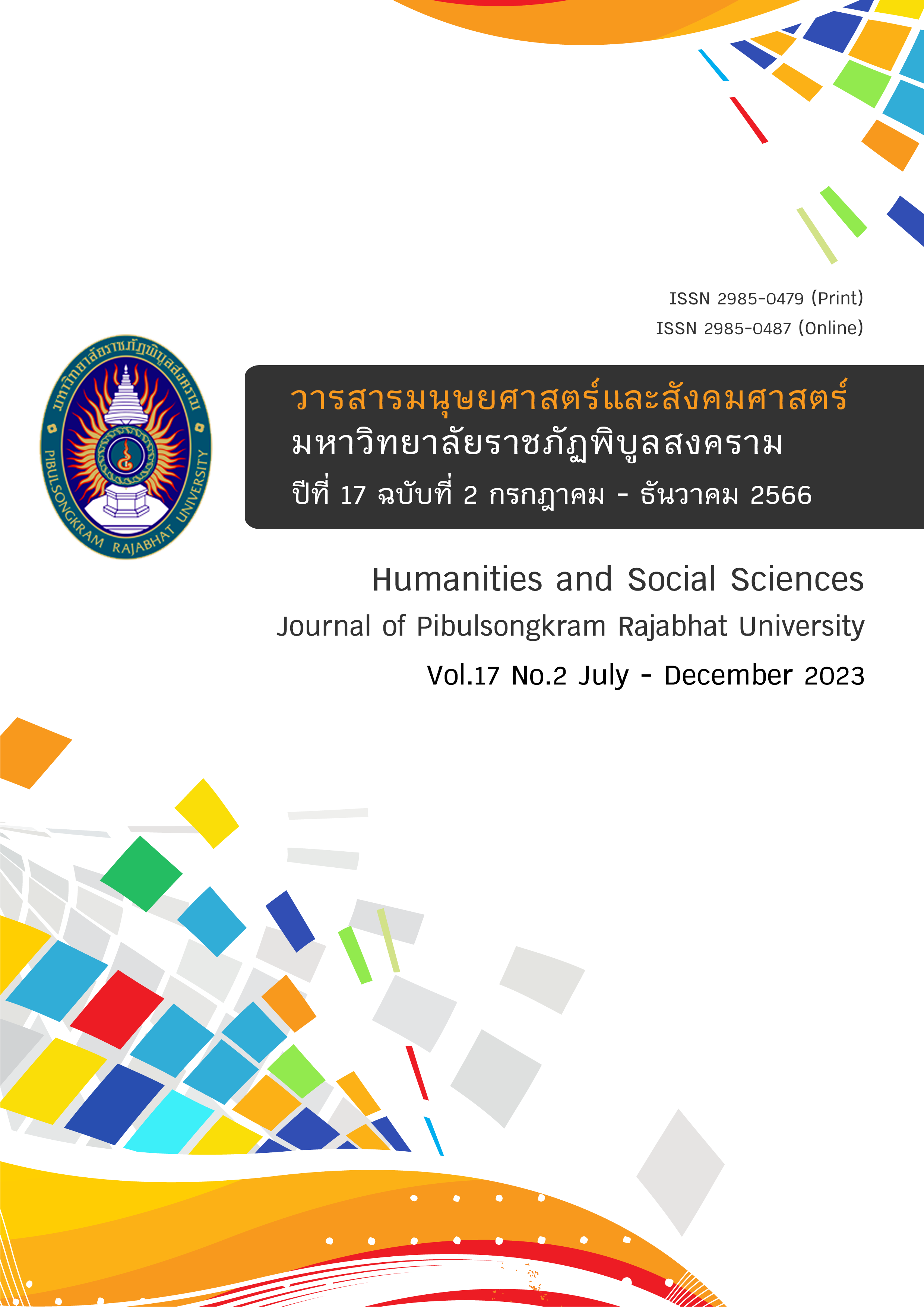Using Communicative Language Teaching Activities to Promote English Listening-Speaking Abilities and Social Skills Among Vocational Certificate Students
DOI:
https://doi.org/10.14456/psruhss.2023.58Keywords:
Communicative language teaching activities, English listening-speaking abilities, Social skillsAbstract
The purposes of this study were 1) to study English listening-speaking abilities of vocational certificate students after being taught through communicative language teaching activities, and 2) to compare social skills of vocational certificate students before and after being taught through communicative language teaching activities. The study population was 25 vocational certificate students, who were enrolled in the English Speaking-Listening course (2000-1203) in the second semester of the academic year 2019 at Chiang Mai Technical College. The research instruments consisted of 5 lesson plans using communicative language teaching activities, the listening-speaking assessment forms and social skills assessments. The data obtained were analyzed by means of mean, standard deviation, and percentage. The findings were as follows: 1) After the students were taught through the communicative language teaching activities, their English listening-speaking abilities passed the preset criteria, at a good level. 2) After the students were taught through the communicative language teaching activities, their social skills increased.
References
กระทรวงศึกษาธิการ. (2554). แผนพัฒนาการศึกษาของกระทรวงศึกษาธิการ ฉบับที่ 11 พ.ศ. 2555-2559. สืบค้น 10 มิถุนายน 2562, จาก http//planning.tu.ac.th
ชรินภรณ์ สัจจธรรมวดี. (2555). การใช้วิธีสอนสตอรีไลน์เพื่อพัฒนาความสามารถทางการฟัง พูดภาษาอังกฤษและทักษะสังคมของนักเรียนชั้นมัธยมศึกษาปีที่ 4 (วิทยานิพนธ์ศึกษาศาสตรมหาบัณฑิต). เชียงใหม่: มหาวิทยาลัยเชียงใหม่.
นาตยา ภัทรแสงไทย. (2525). ยุทธวิธีการสอนสังคมศึกษา. กรุงเทพฯ: โอเดียนสโตร์.
ปัทมาวดี บุณย์สวัสดิ์. (2535). ผลการใช้เกมการละเล่นพื้นบ้านของไทยที่มีผลต่อการพัฒนาทักษะทางสังคมของนักเรียนชั้นประถมศึกษาปีที่ 2 (วิทยานิพนธ์ปริญญาครุศาสตรมหาบัณฑิต). กรุงเทพฯ: จุฬาลงกรณ์มหาวิทยาลัย.
รังสี วิบูลย์อรรถกร. (2534). ความสัมพันธ์ระหว่างทักษะทางสังคมและผลสัมฤทธิ์ทางการเรียนวิชาสังคมของนักเรียนชั้นปีที่ 3 ในสังกัดกรมสามัญศึกษาในจังหวัดปราจีนบุรี (วิทยานิพนธ์ศิลปศาสตรมหาบัณฑิต). กรุงเทพฯ: มหาวิทยาลัยเกษตรศาสตร์.
สถาบันภาษาอังกฤษ คณะกรรมการการศึกษาขั้นพื้นฐาน. (2555). คู่มือการจัดการเรียนการสอน ภาษาอังกฤษแนวใหม่ตามกรอบมาตรฐานความสามารถทางภาษาอังกฤษที่เป็นสากล The Common European Framework of Reference for Languages (CEFR) ระดับชั้นมัธยมศึกษา. กรุงเทพฯ: โรงพิมพ์จุฬาลงกรณ์มหาวิทยาลัย.
สมเกียรติ อ่อนวิมล. (2554). ภาษาอังกฤษกับอนาคตของไทยในอาเซียน. สืบค้น 15 มกราคม 2557, จาก http://blog.eduzones.com/wigi/81880
สำนักงานคณะกรรมการการอาชีวศึกษา. (2561). แนวทางการประเมินคุณภาพการศึกษาของสถานศึกษาตามมาตรฐานการอาชีวศึกษา พ.ศ. 2561. กรุงเทพฯ: สำนักงานคณะกรรมการการอาชีวศึกษา (สอศ.).
สุภัทรา อักษรานุเคราะห์. (2540). การใช้กลวิธีการสื่อสารกับการสอนภาษาอังกฤษ ใน สุมิตรา อังวัฒนกุล (บรรณาธิการ), แนวคิดและเทคนิควิธีการสอนภาษาอังกฤษระดับมัธยมศึกษา (พิมพ์ครั้งที่ 3). กรุงเทพฯ: จุฬาลงกรณ์มหาวิทยาลัย.
สุมิตรา อังวัฒนกุล. (2540). วิธีสอนสื่อสารทักษะฟังภาษาอังกฤษ. กรุงเทพฯ: จุฬาลงกรณ์มหาวิทยาลัย.
Astin, A. W. (1993). What matters in college: Four critical years revisited. San Francisco: Jossey-Bass.
Canale, M., & Swain, M. (1980). Theoretical bases of communicative approaches to second language teaching and testing. Applied linguistics, 1(1), 1-47.
Johnson, D. W., & Johnson, R. T. (1999). Learning together and alone: Cooperative, competitive, and individualistic learning (5th Ed.). Boston: Allyn & Bacon.
Johnson, K., & Morrow, K. (1981). Communicative in the Classroom. England: Burnt Mill Longman.
Kagan, S., & Kagan, S. (1994). Cooperative learning. San Clemente, CA: Kagan.
Littlewood, W., William, L., & Swan, M. (1981). Communicative language teaching: An introduction. Cambridge university press.
Matson, J. L., Rotatori, A. F., & Helsel, W. J. (1983). Development of a rating scale to measure social skills in children: The Matson Evaluation of Social Skills with Youngsters (MESSY). Behaviour Research and therapy, 21(4), 335-340.
Richards, J. C., & Rodgers, T. S. (2014). Approaches and methods in language teaching. New York: Cambridge university press.
Savignon, S. J. (1991). Communicative language teaching: State of the art. TESOL quarterly, 25(2), 261-278.
Sheridan, S. M., Hungelmann, A., & Maughan, D. P. (1999). A contextualized framework for social skills assessment, intervention, and generalization. School Psychology Review, 28(1), 84-103.
Wilkins, D. A. (1976). National Syllabuses. Oxford: Oxford University Press.
Downloads
Published
How to Cite
Issue
Section
License
Copyright (c) 2023 Humanities and Social Sciences Journal of Pibulsongkram Rajabhat University

This work is licensed under a Creative Commons Attribution-NonCommercial-NoDerivatives 4.0 International License.
Any articles or comments appearing in the Journal of Humanities and Social Sciences, Rajabhat Phibulsongkram University, are the intellectual property of the authors, and do not necessarily reflect the views of the editorial board. Published articles are copyrighted by the Journal of Humanities and Social Sciences, Rajabhat Phibulsongkram University.









